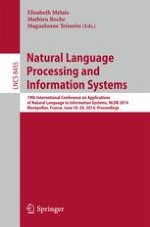2014 | Book
Natural Language Processing and Information Systems
19th International Conference on Applications of Natural Language to Information Systems, NLDB 2014, Montpellier, France, June 18-20, 2014. Proceedings
Editors: Elisabeth Métais, Mathieu Roche, Maguelonne Teisseire
Publisher: Springer International Publishing
Book Series : Lecture Notes in Computer Science
